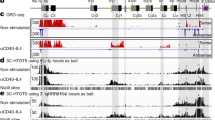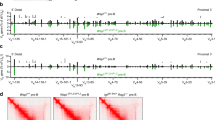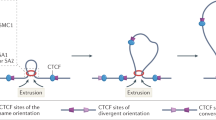Abstract
Immunoglobulin variable region exons are assembled in developing B cells by V(D)J recombination. Once mature, these cells undergo class-switch recombination (CSR) when activated by antigen. CSR changes the heavy chain constant region exons (Ch) expressed with a given variable region exon from Cμ to a downstream Ch (for example, Cγ, Cε or Cα), thereby switching expression from IgM to IgG, IgE or IgA. Both V(D)J recombination and CSR involve the introduction of DNA double-strand breaks and their repair by means of end joining1,2. For CSR, double-strand breaks are introduced into switch regions that flank Cμ and a downstream Ch, followed by fusion of the broken switch regions1. In mammalian cells, the ‘classical’ non-homologous end joining (C-NHEJ) pathway repairs both general DNA double-strand breaks and programmed double-strand breaks generated by V(D)J recombination2,3. C-NHEJ, as observed during V(D)J recombination, joins ends that lack homology to form ‘direct’ joins, and also joins ends with several base-pair homologies to form microhomology joins3,4. CSR joins also display direct and microhomology joins, and CSR has been suggested to use C-NHEJ5,6,7,8. Xrcc4 and DNA ligase IV (Lig4), which cooperatively catalyse the ligation step of C-NHEJ, are the most specific C-NHEJ factors; they are absolutely required for V(D)J recombination and have no known functions other than C-NHEJ2. Here we assess whether C-NHEJ is also critical for CSR by assaying CSR in Xrcc4- or Lig4-deficient mouse B cells. C-NHEJ indeed catalyses CSR joins, because C-NHEJ-deficient B cells had decreased CSR and substantial levels of IgH locus (immunoglobulin heavy chain, encoded by Igh) chromosomal breaks. However, an alternative end-joining pathway, which is markedly biased towards microhomology joins, supports CSR at unexpectedly robust levels in C-NHEJ-deficient B cells. In the absence of C-NHEJ, this alternative end-joining pathway also frequently joins Igh locus breaks to other chromosomes to generate translocations.
This is a preview of subscription content, access via your institution
Access options
Subscribe to this journal
Receive 51 print issues and online access
$199.00 per year
only $3.90 per issue
Buy this article
- Purchase on Springer Link
- Instant access to full article PDF
Prices may be subject to local taxes which are calculated during checkout




Similar content being viewed by others
References
Chaudhuri, J. et al. Evolution of the immunoglobulin heavy chain class switch recombination mechanism. Adv. Immunol. 94, 157–214 (2007)
Rooney, S., Chaudhuri, J. & Alt, F. W. The role of the non-homologous end-joining pathway in lymphocyte development. Immunol. Rev. 200, 115–131 (2004)
Roth, D. B. Restraining the V(D)J recombinase. Nature Rev. Immunol. 3, 656–666 (2003)
Verkaik, N. S. et al. Different types of V(D)J recombination and end-joining defects in DNA double-strand break repair mutant mammalian cells. Eur. J. Immunol. 32, 701–709 (2002)
Manis, J. P. et al. Ku70 is required for late B cell development and immunoglobulin heavy chain class switching. J. Exp. Med. 187, 2081–2089 (1998)
Casellas, R. et al. Ku80 is required for immunoglobulin isotype switching. EMBO J. 17, 2404–2411 (1998)
Reina-San-Martin, B. et al. H2AX is required for recombination between immunoglobulin switch regions but not for intra-switch region recombination or somatic hypermutation. J. Exp. Med. 197, 1767–1778 (2003)
Pan-Hammarstrom, Q. et al. Impact of DNA ligase IV on nonhomologous end joining pathways during class switch recombination in human cells. J. Exp. Med. 201, 189–194 (2005)
Gao, Y. et al. A critical role for DNA end-joining proteins in both lymphogenesis and neurogenesis. Cell 95, 891–902 (1998)
Yan, C. T. et al. XRCC4 suppresses medulloblastomas with recurrent translocations in p53-deficient mice. Proc. Natl Acad. Sci. USA 103, 7378–7383 (2006)
Manis, J. P., Dudley, D., Kaylor, L. & Alt, F. W. IgH class switch recombination to IgG1 in DNA-PKcs-deficient B cells. Immunity 16, 607–617 (2002)
Gao, Y. et al. Interplay of p53 and DNA-repair protein XRCC4 in tumorigenesis, genomic stability and development. Nature 404, 897–900 (2000)
Kraus, M., Alimzhanov, M. B., Rajewsky, N. & Rajewsky, K. Survival of resting mature B lymphocytes depends on BCR signaling via the Igα/β heterodimer. Cell 117, 787–800 (2004)
Zarrin, A. A. et al. Antibody class switching mediated by yeast endonuclease-generated DNA breaks. Science 315, 377–381 (2007)
Bryans, M., Valenzano, M. C. & Stamato, T. D. Absence of DNA ligase IV protein in XR-1 cells: evidence for stabilization by XRCC4. Mutat. Res. 433, 53–58 (1999)
Frank, K. M. et al. Late embryonic lethality and impaired V(D)J recombination in mice lacking DNA ligase IV. Nature 396, 173–177 (1998)
Franco, S. et al. H2AX prevents DNA breaks from progressing to chromosome breaks and translocations. Mol. Cell 21, 201–214 (2006)
Wang, H. et al. DNA ligase III as a candidate component of backup pathways of nonhomologous end joining. Cancer Res. 65, 4020–4030 (2005)
Roth, D. B. Amplifying mechanisms of lymphomagenesis. Mol. Cell 10, 1–2 (2002)
Kabotyanski, E. B., Gomelsky, L., Han, J. O., Stamato, T. D. & Roth, D. B. Double-strand break repair in Ku86- and XRCC4-deficient cells. Nucleic Acids Res. 26, 5333–5342 (1998)
Guirouilh-Barbat, J. et al. Impact of the KU80 pathway on NHEJ-induced genome rearrangements in mammalian cells. Mol. Cell 14, 611–623 (2004)
Zhu, C. et al. Unrepaired DNA breaks in p53-deficient cells lead to oncogenic gene amplification subsequent to translocations. Cell 109, 811–821 (2002)
Audebert, M., Salles, B. & Calsou, P. Involvement of poly(ADP-ribose) polymerase-1 and XRCC1/DNA ligase III in an alternative route for DNA double-strand breaks rejoining. J. Biol. Chem. 279, 55117–55126 (2004)
Daley, J. M. & Wilson, T. E. Rejoining of DNA double-strand breaks as a function of overhang length. Mol. Cell. Biol. 25, 896–906 (2005)
Gu, J. et al. XRCC4:DNA ligase IV can ligate incompatible DNA ends and can ligate across gaps. EMBO J. 26, 1010–1023 (2007)
Schrader, C. E., Vardo, J. & Stavnezer, J. Role for mismatch repair proteins Msh2, Mlh1, and Pms2 in immunoglobulin class switching shown by sequence analysis of recombination junctions. J. Exp. Med. 195, 367–373 (2002)
Ehrenstein, M. R., Rada, C., Jones, A. M., Milstein, C. & Neuberger, M. S. Switch junction sequences in PMS2-deficient mice reveal a microhomology-mediated mechanism of Ig class switch recombination. Proc. Natl Acad. Sci. USA 98, 14553–14558 (2001)
Komori, T., Okada, A., Stewart, V. & Alt, F. W. Lack of N regions in antigen receptor variable region genes of TdT-deficient lymphocytes. Science 261, 1171–1175 (1993)
Chen, S. et al. Accurate in vitro end joining of a DNA double strand break with partially cohesive 3′-overhangs and 3′-phosphoglycolate termini: effect of Ku on repair fidelity. J. Biol. Chem. 276, 24323–24330 (2001)
Weinstock, D. M., Richardson, C. A., Elliott, B. & Jasin, M. Modeling oncogenic translocations: distinct roles for double-strand break repair pathways in translocation formation in mammalian cells. DNA Repair (Amst.) 5, 1065–1074 (2006)
Corneo, B. et al. Rag mutations reveal robust alternative end joining. Nature doi: 10.1038/nature06168 (in the press)
Jones, K. R. et al. Radiosensitization of MDA-MB-231 breast tumor cells by adenovirus-mediated overexpression of a fragment of the XRCC4 protein. Mol. Cancer Ther. 4, 1541–1550 (2005)
Acknowledgements
We thank D. Schatz for the gift of the Lig4 antibody, M. Alimzhanov, S. Casola and J.-B. Telliez for technical assistance and suggestions, and members of the Alt laboratory for discussions. This work was supported by NIH grants (to F.W.A.), an NIH postdoctoral training grant (to C.T.Y.) and a Long-Term Fellowship of the European Molecular Biology Organization (to S.F.). F.W.A. is an investigator of the Howard Hughes Medical Institute.
Author Contributions F.W.A. and C.T.Y. planned the studies and analysed and interpreted the data. C.T.Y. generated the reagents and performed or oversaw all the experiments described. E.K.S. along with C.T.Y. purified and stimulated XP-T/HL B cells for the studies described. C.B. with C.T.Y. generated and analysed the LP-T/HL mice. E.K.S. generated and analysed (with C.T.Y.) most of the switch junctions and performed all statistical analysis. C.T.Y., T.R.H., S.F. and S.G. analysed metaphases for telomere-FISH and IgH FISH. C.T.Y., T.R.H., E.K.S. and C.B. performed ELISPOT analysis with technical assistance and reagents from A.A.Z. C.B. with E.K.S. isolated and analysed hybridoma sequence junctions; J.P.M. with M.G. provided expertise in B-cell stimulation, fluorescence-activated cell sorting and analysis of sequence junctions; and K.R. provided CD21-cre and HL mice and helped interpret data. F.W.A. and C.T.Y. wrote the paper.
Author information
Authors and Affiliations
Corresponding author
Ethics declarations
Competing interests
Reprints and permissions information is available at www.nature.com/reprints. The authors declare no competing financial interests.
Supplementary information
Supplementary Information
This file contains Supplementary Figures 1-16 with Legends and Supplementary Tables 1-7 (PDF 2401 kb)
Rights and permissions
About this article
Cite this article
Yan, C., Boboila, C., Souza, E. et al. IgH class switching and translocations use a robust non-classical end-joining pathway. Nature 449, 478–482 (2007). https://doi.org/10.1038/nature06020
Received:
Accepted:
Published:
Issue Date:
DOI: https://doi.org/10.1038/nature06020
This article is cited by
-
ATR kinase supports normal proliferation in the early S phase by preventing replication resource exhaustion
Nature Communications (2023)
-
Polλ promotes microhomology-mediated end-joining
Nature Structural & Molecular Biology (2023)
-
Rad52 mediates class-switch DNA recombination to IgD
Nature Communications (2022)
-
Fam72a enforces error-prone DNA repair during antibody diversification
Nature (2021)
-
Noncoding RNA processing by DIS3 regulates chromosomal architecture and somatic hypermutation in B cells
Nature Genetics (2021)
Comments
By submitting a comment you agree to abide by our Terms and Community Guidelines. If you find something abusive or that does not comply with our terms or guidelines please flag it as inappropriate.



